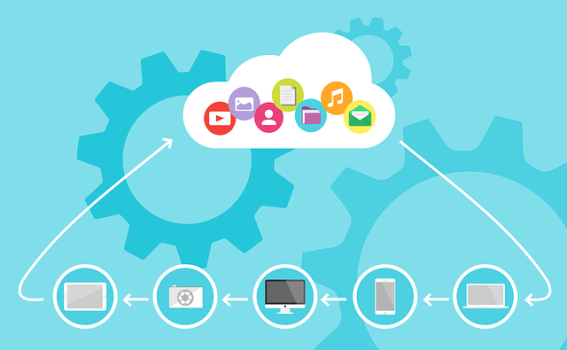Cloud computing
Cloud computing is the on-demand availability of computer system resources, especially data storage and computing power, without direct active management by the user. The term is generally used to describe data centers available to many users over the Internet. In simple terms, cloud computing is a way to use technology to make it easier for you to do your work. With cloud computing, you can access your files and applications from any device with an Internet connection. You can also share files and collaborate with other people in real time.
All about Cloud computing and its related technologies
Cloud computing is the delivery of computing services—including servers, storage, databases, networking, software, analytics, and intelligence—over the Internet (“the cloud”) to offer faster innovation, flexible resources, and economies of scale.
The National Institute of Standards and Technology (NIST) defines cloud computing as “a model for enabling ubiquitous, convenient, on-demand network access to a shared pool of configurable computing resources (e.g., networks, servers, storage, applications, and services) that can be rapidly provisioned and released with minimal management effort or service provider interaction.”
In other words: Cloud computing is the ability to access technology services—including storage, compute power, databases, networking—over the Internet from a company that specializes in delivering those services. When you use cloud services instead of in-house hardware and software resources to meet your IT needs, you get all the advantages that come with accessing those services from the world’s leading providers.
Advantages like increased agility and speed to market because you can provision new resources in minutes or hours instead of weeks or months; reduced capital expenses because you only pay for what you use; reduced operational expenses because you no longer need to staff and manage on-premises infrastructure; improved security because leading providers invest heavily in securing their data centers and networks; and much more.
What is Cloud computing?
Cloud computing is a model for enabling ubiquitous, convenient, on-demand network access to a shared pool of configurable computing resources (e.g., networks, servers, storage, applications, and services) that can be rapidly provisioned and released with minimal management effort or service provider interaction. This cloud model is composed of five essential characteristics, three service models, and four deployment models.
The five essential characteristics of cloud computing are:
On-demand self-service: A consumer can unilaterally provision compute capabilities, such as server time and network storage, as needed automatically without requiring human interaction with each service provider.
Broad network access: Capabilities are available over the network and accessed through standard mechanisms that promote use by heterogeneous thin or thick client platforms (e.g., mobile phones, laptops, and PDAs).
Resource pooling: The provider’s computing resources are pooled to serve multiple consumers using a multi-tenant model, with different physical and virtual resources dynamically assigned and reassigned according to demand. There is a sense of location independence in that the customer generally has no control or knowledge over the exact location of the provided resources but may be able to specify location at a higher level of abstraction (e.g., country, state, or datacenter). Examples of resources include storage, processing, memory, and network bandwidth.
Rapid elasticity: Capabilities can be elastically provisioned and released to scale rapidly outward and inward commensurate
How does it work?
Cloud computing is a model for enabling ubiquitous, convenient, on-demand network access to a shared pool of configurable computing resources (e.g., networks, servers, storage, applications, and services) that can be rapidly provisioned and released with minimal management effort or service provider interaction.
This cloud model is composed of five essential characteristics, three service models, and four deployment models.
Essential characteristics:
On-demand self-service: A consumer can unilaterally provision computing capabilities, such as server time and network storage, as needed automatically without requiring human interaction with each service provider.
Broad network access: Capabilities are available over the network and accessed through standard mechanisms that promote use by heterogeneous thin or thick client platforms (e.g., mobile phones, laptops, and PDAs).
Resource pooling: The provider’s computing resources are pooled to serve multiple consumers using a multi-tenant model, with different physical and virtual resources dynamically assigned and reassigned according to demand. There is a sense of location independence in that the customer generally has no control or knowledge over the exact location of the provided resources but may be able to specify location at a higher level of abstraction (e.g., country, state, or datacenter). Examples of resources include storage systems, processors, memory arrays, and networks.
Rapid elasticity: Capabilities can be elastically provisioned and released, in some cases automatically, to scale rapidly outward and inward
Advantages and disadvantages of Cloud computing
Cloud computing has many advantages over traditional on-premises computing. Perhaps the most significant advantage is that it can help organizations save money on hardware, software, and IT infrastructure costs. With cloud computing, organizations can pay for only the resources they need, when they need them, and scale up or down as their needs change.
Another advantage of cloud computing is that it can make it easier for organizations to be more agile and responsive to changes in their business environment. For example, if a company needs to launch a new product or service quickly, it can do so more easily with cloud-based resources than with on-premises resources.
There are also some disadvantages to using cloud computing services. One such disadvantage is that an organization may be less control over its data and applications when they are stored in the cloud. Another potential disadvantage is that an organization may be reliant on the availability of internet connectivity to access its data and applications stored in the cloud.
What are the different types of Cloud computing?
Cloud computing is a model for enabling ubiquitous, convenient, on-demand network access to a shared pool of configurable computing resources (e.g., networks, servers, storage, applications, and services). This cloud model is composed of five essential characteristics, three service models, and four deployment models.
Essential Characteristics:
On-demand self-service: A consumer can unilaterally provision computing capabilities, such as server time and network storage, as needed automatically without requiring human interaction with each service provider.
Broad network access: Capabilities are available over the network and accessed through standard mechanisms that promote use by heterogeneous thin or thick client platforms (e.g., mobile phones, laptops, and PDAs).
Resource pooling: The provider’s computing resources are pooled to serve multiple consumers using a multi-tenant model with different physical and virtual resources dynamically assigned and reassigned according to consumer demand. There is a sense of location independence in that the customer generally has no control or knowledge over the exact location of the provided resources but may be able to specify location at a higher level of abstraction (e.g., country, state, or datacenter). Examples of resources include storage, processing, memory, network bandwidth, and virtual machines.
Rapid elasticity: Capabilities can be rapidly and elastically provisioned in response to consumer demand change via auto-scaling. You can scale up or down manually depending on your needs.
Measured service
How to get started with cloud computing
Cloud computing is a model for enabling ubiquitous, convenient, on-demand network access to a shared pool of configurable computing resources (e.g., networks, servers, storage, applications, and services). This technology allows you to use applications without installation and access your personal files at any computer with internet access.
To get started with cloud computing, you first need to determine what services you want to use and what providers offer those services. Once you’ve selected a provider, you can create an account and begin using the services.
Conclusion
Cloud computing is an emerging technology that promises to revolutionize the way businesses and individuals access and use information. It offers a new model for IT services delivery that is more flexible, scalable, and cost-effective than traditional on-premises alternatives. While the concept of cloud computing is still evolving, the potential benefits it offers are already becoming apparent. As organizations continue to learn more about how cloud computing works and its potential applications, they are increasingly adopting this innovative approach to meeting their IT needs.






